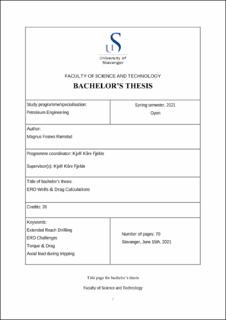| dc.contributor.advisor | Fjelde, Kjell Kåre | |
| dc.contributor.author | Ramstad, Magnus Fosnes | |
| dc.date.accessioned | 2021-09-07T16:31:39Z | |
| dc.date.available | 2021-09-07T16:31:39Z | |
| dc.date.issued | 2021 | |
| dc.identifier | no.uis:inspera:78834598:36872533 | |
| dc.identifier.uri | https://hdl.handle.net/11250/2774463 | |
| dc.description.abstract | This thesis investigated Extended reach drilling (ERD), which is the term for drilling high-angle, long horizontal directional wells. ERD wells has had tremendous developments, as new technology continues to break worlds records. Since the breakthrough at Wytch farm in 1997, the then world record extended reach well with a horizontal displacement of more than 10.1 km, the world record has been beaten many times. As of writing, the current world record for longest step out ERD well is drilled by ExxonMobil at Sakhalin island, with a step out of more than 14.1 km.
The objective of this thesis was to introduce different challenges in planning and drilling of a well, and then look at the further challenges in an ERD well. ERD wells often have the same challenges as other directional wells, but at a higher scale. The thesis will explore different aspects related to directional drilling and associated challenges. In addition, it introduces some types of engineering studies that must be performed during the planning of ERD wells, such as torque, drag, buckling, and corresponding limitations.
Furthermore, this thesis investigated an example of a 2D extended reach well profile, which was used to calculate the axial load on the drillstring during tripping out (POOH), and the total force on the drillstring during tripping in (RIH). For these two scenarios, sensitivity analysis was made to observe what where to happen if one changed some of the parameters set beforehand. Both variation in sail angle and friction coefficient were analyzed in the tripping out scenario, while both liner length and friction coefficient were analyzed in the tripping out scenario. | |
| dc.description.abstract | This thesis investigated Extended reach drilling (ERD), which is the term for drilling high-angle, long horizontal directional wells. ERD wells has had tremendous developments, as new technology continues to break worlds records. Since the breakthrough at Wytch farm in 1997, the then world record extended reach well with a horizontal displacement of more than 10.1 km, the world record has been beaten many times. As of writing, the current world record for longest step out ERD well is drilled by ExxonMobil at Sakhalin island, with a step out of more than 14.1 km.
The objective of this thesis was to introduce different challenges in planning and drilling of a well, and then look at the further challenges in an ERD well. ERD wells often have the same challenges as other directional wells, but at a higher scale. The thesis will explore different aspects related to directional drilling and associated challenges. In addition, it introduces some types of engineering studies that must be performed during the planning of ERD wells, such as torque, drag, buckling, and corresponding limitations.
Furthermore, this thesis investigated an example of a 2D extended reach well profile, which was used to calculate the axial load on the drillstring during tripping out (POOH), and the total force on the drillstring during tripping in (RIH). For these two scenarios, sensitivity analysis was made to observe what where to happen if one changed some of the parameters set beforehand. Both variation in sail angle and friction coefficient were analyzed in the tripping out scenario, while both liner length and friction coefficient were analyzed in the tripping out scenario. | |
| dc.language | eng | |
| dc.publisher | uis | |
| dc.title | ERD Wells & Drag Calculations | |
| dc.type | Bachelor thesis | |
